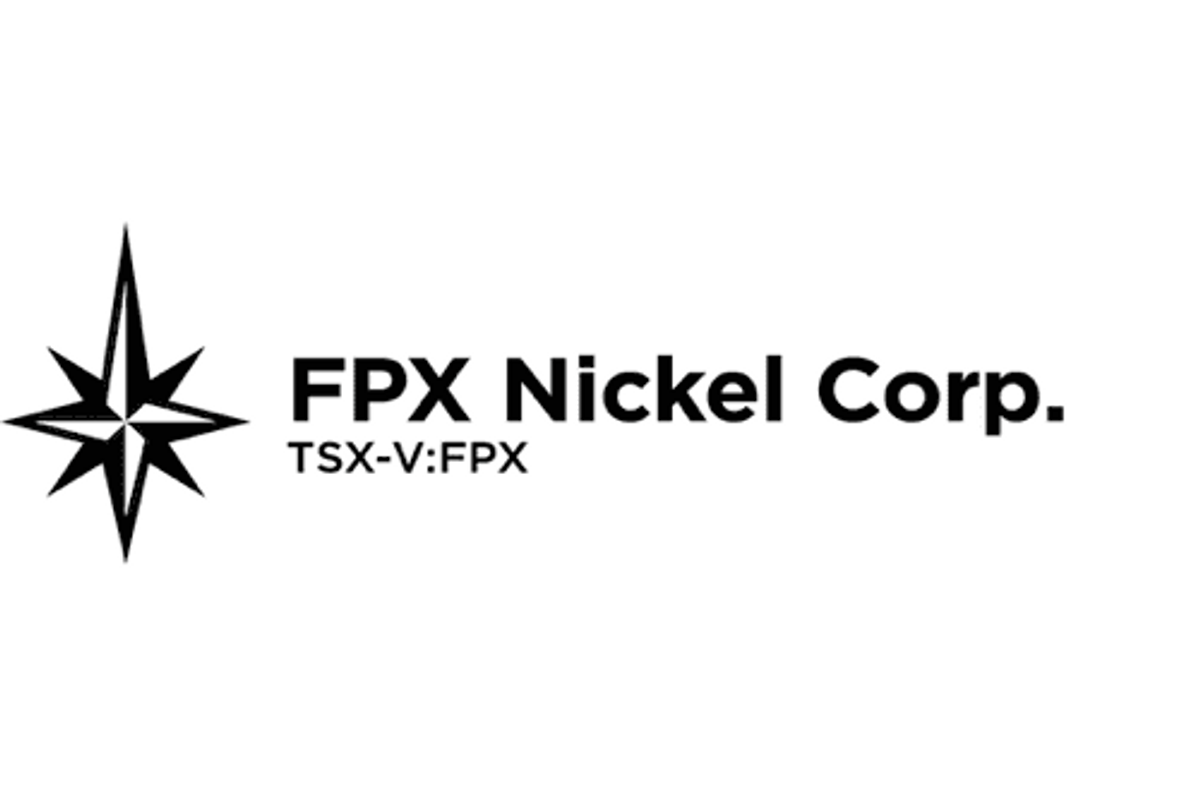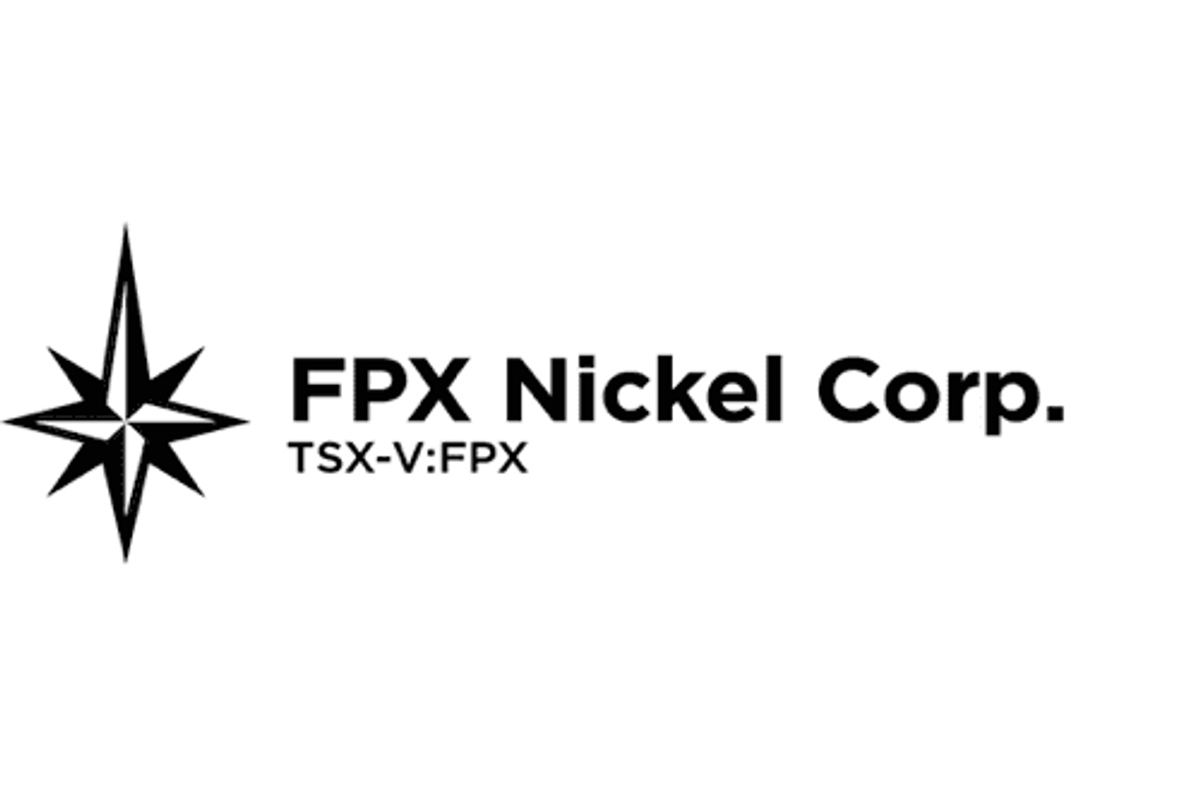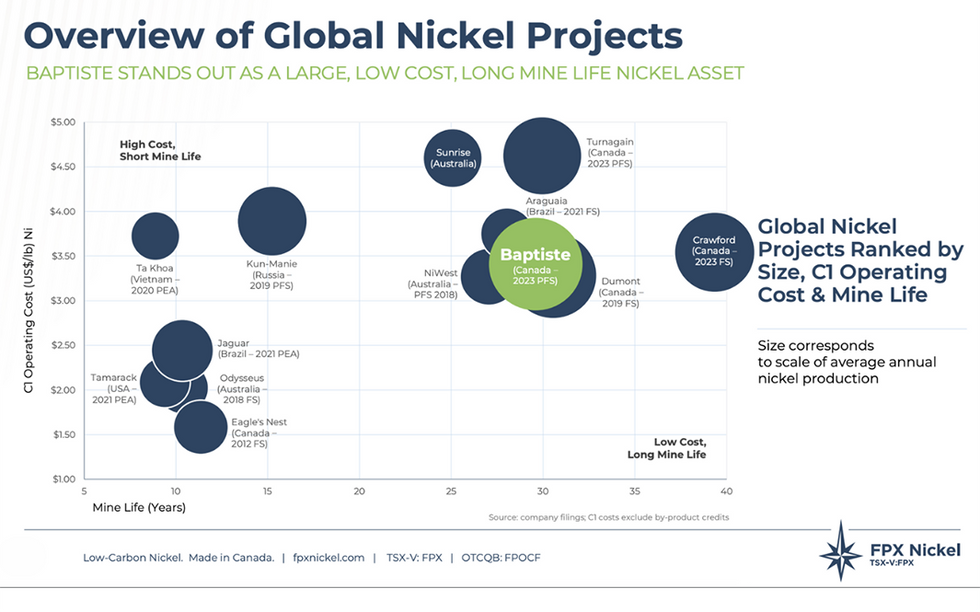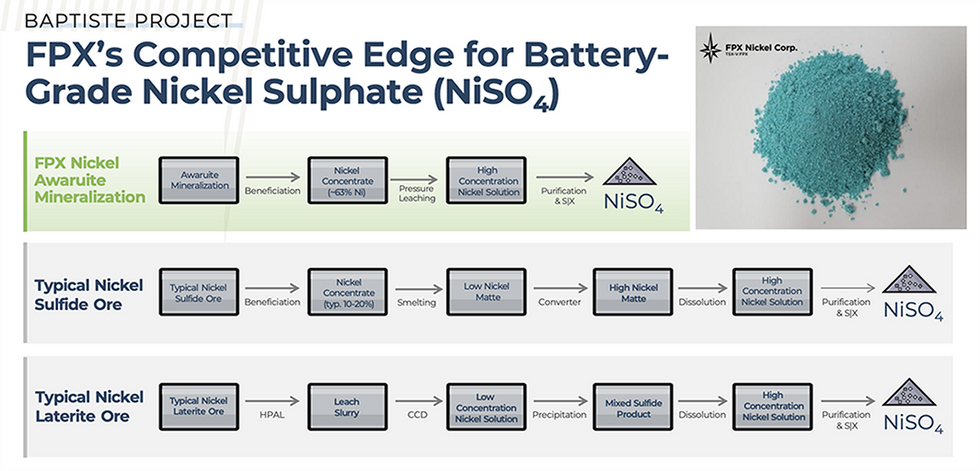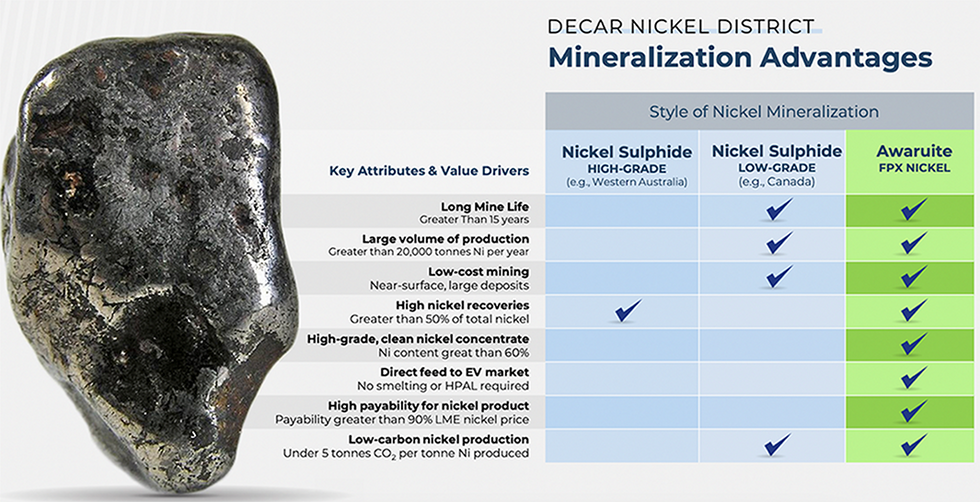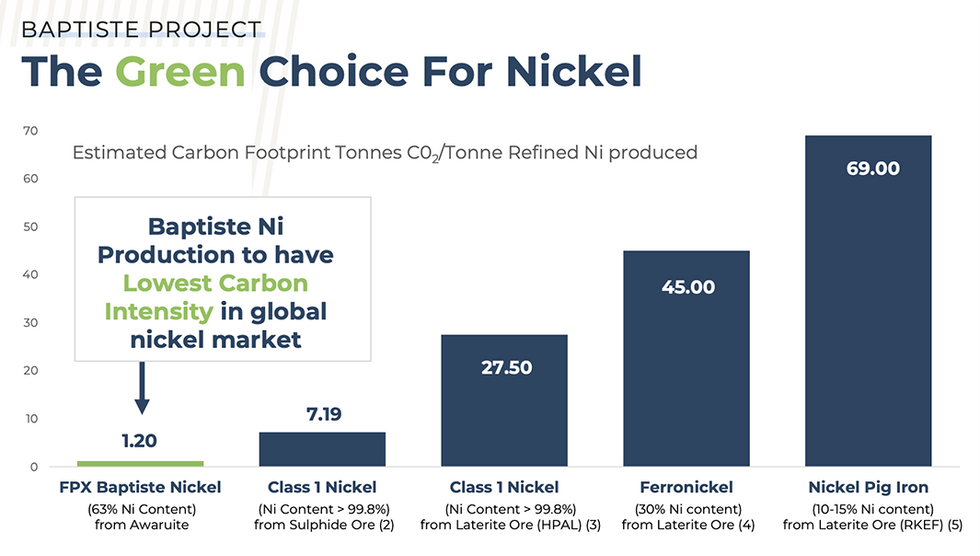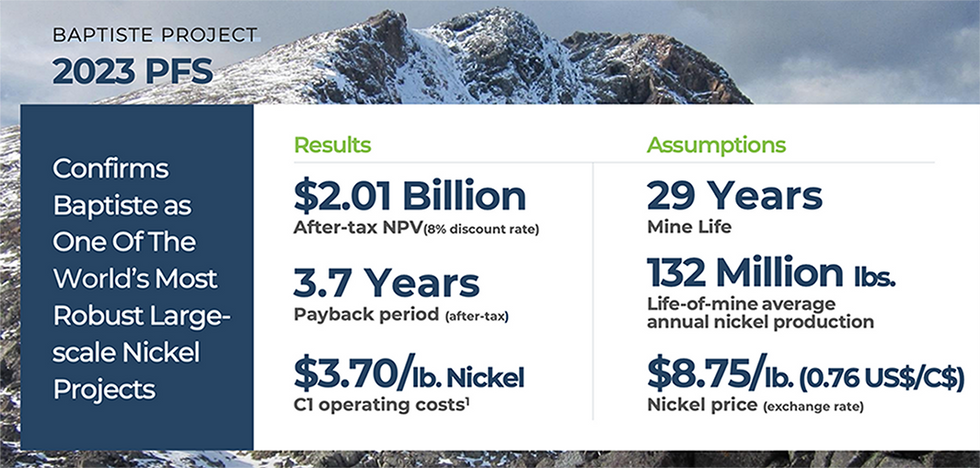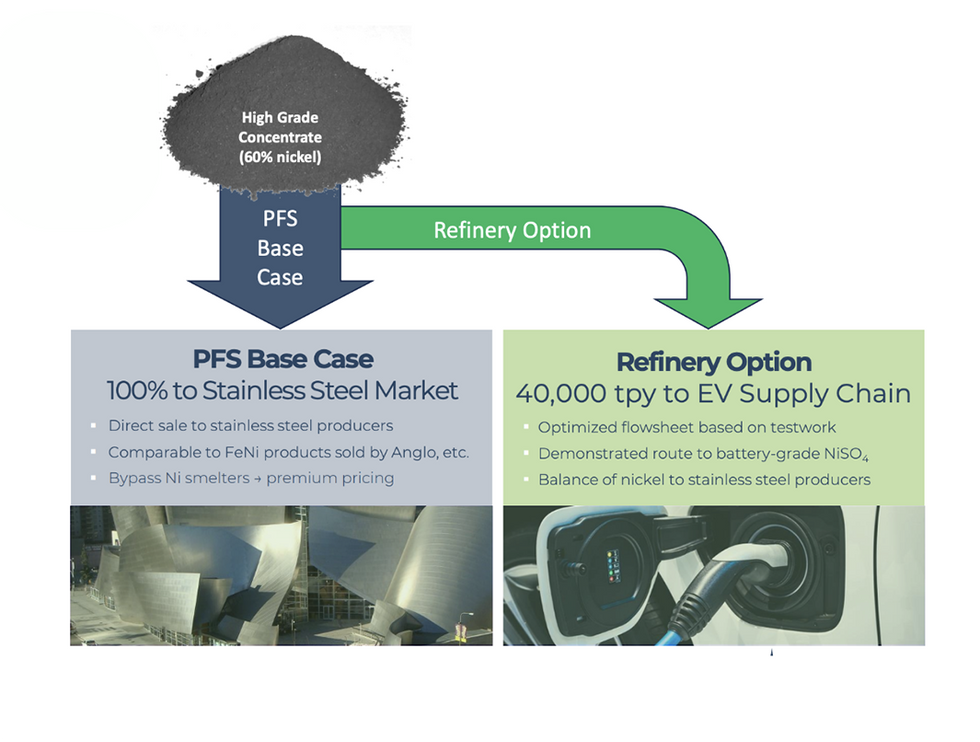FPX Nickel Corp. (TSXV: FPX) (OTCQB: FPOCF) (" FPX " or the " Company ") is pleased to announce the first step-out drillhole results confirming continued near-surface lateral extension of strong nickel mineralization at the Van Target (" Van ") in the Company's Decar Nickel District (" Decar " or the " District ") in central British Columbia. The first three widely-spaced holes drilled this year at Van, which is located 6 km north of the Baptiste Deposit (" Baptiste "), returned some of the strongest results in the District's history, highlighted by the results of 22VAN-012, which intersected the highest-grading broad interval of near-surface nickel mineralization drilled to-date at Van.
Highlights
- Van step-out drillholes show that the strong mineralization in previously reported outcrop samples continues to depth southwest of the zone first drilled in 2021
- Hole 22VAN-010 intersected 346.3 m grading 0.133% DTR Nickel from the start of bedrock at 51.3 m downhole to the end of hole, including 136.0 m of 0.143% DTR Nickel from 91.0 m downhole
- Hole 22VAN-012 intersected 334.5 m grading 0.120% DTR Nickel from 6.0 m downhole, including 176.0 m of 0.142% DTR Ni from 6.0 m downhole, and further including 100.0 m of 0.150% DTR Ni from 70.0 m downhole
- Nickel mineralization at Van is the same as Baptiste, occurring as disseminated awaruite (nickel-iron alloy) and in ophiolite host rocks
- The results at Van compare favourably with previous drilling results at Baptiste, which contains 1.815 billion tonnes of indicated resources at an average grade of 0.129% DTR nickel , plus 339 million tonnes of inferred resources with an average grade of 0.131% DTR nickel ( both reported at a cut-off grade of 0.06% DTR nickel). Mineral resources are not mineral reserves and do not have demonstrated economic viability. See the summary of the Baptiste mineral resource estimate set out in FPX's November 14, 2022 news release
"We are very pleased with these first step-out drill results from Van, confirming the potential for this target to host a large-scale, standalone nickel deposit to rival the deposit already delineated at Baptiste," commented Martin Turenne , the Company's President and CEO. "Based on the drill results reported to-date from the 2021 and 2022 programs, we have delineated consistently strong near-surface nickel mineralization in drilling over an area measuring approximately 1 km long by 1 km wide, to downhole depths over 300 m . The remaining drillholes completed in this year's ten-drillhole program stepped out to the west of this mineralized zone; we look forward to reporting assays from those remaining holes in January."
Link to view drill results within interactive 3D VRIFY model (for best results, view in full screen):
https://vrify.com/decks/12221?auth=9bf57cc7-fec5-457f-9a4a-6b96e3653f4b
Van Target Drilling
The results of 22VAN-010, 22VAN-011 and 22VAN-012 are the first from a step-out drill program consisting of 10 holes and totaling 2,504 meters at the Van Target, which is located 6 km north of Baptiste at similar elevations (see Figure 1). This year's step-out program was designed to expand the large mineralized zone identified during 2021's successful inaugural drill program.
Table 1 – Van Target Drillhole Results
Hole | Intersections 1 | DTR Nickel | Total Nickel | ||
From (m) | To (m) | Intersected | |||
22VAN-010 | 51.3 | 397.6 | 346.3 | 0.133 | 0.181 |
including | 91.0 | 227.0 | 136.0 | 0.143 | 0.193 |
22VAN-011 | 31.3 | 91.5 | 60.2 | 0.071 | 0.220 |
22VAN-011 terminated due to poor ground conditions | |||||
22VAN-012 | 6.0 | 340.5 | 334.5 | 0.120 | 0.205 |
including | 6.0 | 182.0 | 176.0 | 0.142 | 0.195 |
including | 70.0 | 170.0 | 100.0 | 0.150 | 0.193 |
and | 182.0 | 340.5 | 158.5 | 0.095 | 0.216 |
1 The vertical depth (true width) of all quoted intersections in this news release is interpreted to be approximately 70% of downhole length.
2 All mineralized core samples are assayed for "total nickel" and "Davis Tube Recoverable (" DTR ") nickel." "DTR nickel" analyses measure only the magnetically recoverable nickel hosted in medium- to coarse-grained awaruite (nickel-iron alloy), whereas the "total nickel" analyses measures both magnetically and non-magnetically recoverable nickel, the latter hosted in fine-grained awaruite or nickel sulphide minerals. The Davis Tube method is a bench-scale metallurgical test procedure which provides an estimation of magnetically recoverable nickel and is the global industry-standard geometallurgical test for magnetic recovery operations and exploration projects. See "Sampling and Analytical Method", below.
The nickel mineralization intersected within 22VAN-010, 22VAN-011 and 22VAN-012 is characterized by disseminated, medium to coarse-grained awaruite (nickel-iron alloy) mineralization hosted in serpentinized ophiolitic rocks and is analogous to the mineralization and geological setting at the Baptiste Deposit.
22VAN-010 was collared proximal to 21VAN-03 and drilled to the southwest at minus 55 degrees. The drillhole encountered bedrock at 51.3 m downhole and thereafter intersected 346.3 m of strong awaruite mineralization, grading 0.133% DTR nickel to a downhole depth of 397.6 m . 22VAN-010 is notable for a broad intercept of strong nickel mineralization at relatively shallow depths, including 0.143% DTR Ni over 136 m starting at a downhole depth of 91.0 m . Mineralization in this drillhole remains open at depth.
22VAN-011 was collared 400 m southwest from 22VAN-010 and proximal to 21VAN-002 and was drilled to the southwest at an angle of minus 55 degrees. The drillhole encountered bedrock at 31.3 m downhole and thereafter intersected 60.2 m of low-grade awaruite mineralization, to a downhole depth of 91.5 m . The strongest mineralization at 22VAN-011 was encountered at the bottom of the drillhole; however the drillhole was terminated in medium-grade awaruite mineralization due to poor ground conditions.
22VAN-012 was collared 400 m southwest from 22VAN-011 proximal to 21VAN-005 and was drilled to the southwest at an angle of minus 55 degrees. The drillhole encountered bedrock at 6.0 m downhole and thereafter intersected 334.5 m of strong awaruite mineralization, grading 0.120% DTR nickel to a downhole depth of 340.5 m . 22VAN-012 is notable for a broad intercept of strong nickel mineralization at the top of the drillhole, including 0.143% DTR Ni over 176 m starting at a downhole depth of 6.0 m . Mineralization in this drillhole remains open at depth.
Collar locations for the ten drillholes drilled at the Van Target in 2022 are provided in Figure 2. Drillholes were spaced approximately 350 to 400 m apart and tested the Van Target over an area of approximately 2 km 2 to a maximum downhole depth of 439 m . Assays are pending for holes 22VAN-013 to 22VAN-019.
Sampling and Analytical Method
HQ & NQ size drill core were quartered and halved, respectively, on-site using a diamond blade core cutting saw. Drill core was sampled continuously downhole at nominal 4 m intervals with the exception of post mineralization dikes and non-mineralized rock types as they historically have had zero grade. Samples were bagged and sealed with tamper proof tags and shipped to Activation Laboratories in Kamloops, British Columbia , for sample preparation. Sample preparation involved crushing the entire sample to 90% passing 2 mm, riffle splitting 250 g, and pulverizing the split to 95% passing 74 microns. Analytical work was completed at Activation Laboratories in Ancaster, Ontario and included lithium metaborate/tetraborate fusion ICP and DTR Ni analysis. DTR Ni analysis involved processing a 30 g split of the pulp through a Davis tube magnetic separator as a slurry using a constant flow rate of 400 millilitres per minute, a magnetic field strength of 3,500 Gauss, and a tube angle of 45 degrees to produce magnetic and non-magnetic fractions. The magnetic and non-magnetic fractions were dried, weighed and the magnetic fraction was analyzed by fusion X-Ray Fluorescence (" XRF ") for multiple elements, including nickel, cobalt, iron and chromium. The DTR nickel grade was then calculated by multiplying the XRF fusion nickel value by the weight of the magnetic fraction, and dividing by the total recorded feed weight.
QA/QC procedures involved the analysis of field and prepared duplicates, DTR replicates, insertion of certified reference materials, and non-certified blanks to assess the accuracy and precision of the Davis tube magnetic separation and XRF analysis that are used to determine the DTR nickel content. The Davis Tube method is a bench-scale metallurgical test procedure which provides an estimation of magnetically recoverable nickel and is the global industry-standard geometallurgical test for magnetic recovery for operations and exploration projects.
Erin Wilson , P. Geo., FPX Nickel's Qualified Person under NI 43-101, has reviewed and approved the technical content of this news release.
About the Decar Nickel District
The Company's Decar Nickel District claims cover 245 km 2 of the Mount Sidney Williams ultramafic/ophiolite complex, 90 km northwest of Fort St. James in central British Columbia . The District is a two-hour drive from Fort St. James on a high-speed logging road.
Decar hosts a greenfield discovery of nickel mineralization in the form of a naturally occurring nickel-iron alloy called awaruite (Ni 3 Fe), which is amenable to bulk-tonnage, open-pit mining. Awaruite mineralization has been identified in four target areas within this ophiolite complex, being the Baptiste Deposit, and the B, Sid and Van targets, as confirmed by drilling, petrographic examination, electron probe analyses and outcrop sampling on all four targets. Since 2010, approximately US $28 million has been spent on the exploration and development of Decar.
Of the four targets in the Decar Nickel District, the Baptiste Deposit, which was initially the most accessible and had the biggest known surface footprint, has been the focus of diamond drilling since 2010, with a total of 99 drillholes and 33,700 m of drilling completed. The Sid target was tested with two holes in 2010 and the B target had a single hole drilled in 2011; all three holes intersected nickel-iron alloy mineralization over wide intervals with DTR nickel grades comparable to the Baptiste Deposit. In 2021, the Company executed an inaugural drilling program at Van which returned results comparable with the strongest results at Baptiste.
About FPX Nickel Corp.
FPX Nickel Corp. is focused on the exploration and development of the Decar Nickel District, located in central British Columbia , and other occurrences of the same unique style of naturally occurring nickel-iron alloy mineralization known as awaruite.
On behalf of FPX Nickel Corp.
"Martin Turenne"
Martin Turenne , President, CEO and Director
Forward-Looking Statements
Certain of the statements made and information contained herein is considered "forward-looking information" within the meaning of applicable Canadian securities laws. These statements address future events and conditions and so involve inherent risks and uncertainties, as disclosed in the Company's periodic filings with Canadian securities regulators. Actual results could differ from those currently projected. The Company does not assume the obligation to update any forward-looking statement.
Neither the TSX Venture Exchange nor its Regulation Services Provider accepts responsibility for the adequacy or accuracy of this release.
SOURCE FPX Nickel Corp.

![]() View original content to download multimedia: https://www.newswire.ca/en/releases/archive/December2022/12/c7815.html
View original content to download multimedia: https://www.newswire.ca/en/releases/archive/December2022/12/c7815.html
